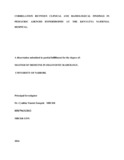| dc.contributor.author | Sempele, Cynthia Y | |
| dc.date.accessioned | 2016-12-23T04:59:12Z | |
| dc.date.available | 2016-12-23T04:59:12Z | |
| dc.date.issued | 2016 | |
| dc.identifier.uri | http://hdl.handle.net/11295/98360 | |
| dc.description.abstract | INTRODUCTION / BACKGROUND
Adenotonsillectomy is one of the commonest ENT procedures at KNH . It is done in children
with ATH to resolve obstructive symptoms and prevent complications like cor pulmonale.
Children with ATH commonly present with mouth breathing and other obstructive symptoms
such as: difficulty in breathing, sleep apnea and snoring. The post nasal space radiograph is used
for evaluation of these children, and various methods are used for its assessment.
OBJECTIVE
The aim of this dissertation was to investigate the clinical and radiological assessment in adenoid
hypertrophy, correlate them and obtain a simple, reproducible and accurate method that can be
used for objective radiograph interpretation.
METHODOLOGY
A total of 55 children were enrolled into the study. Clinical assessment in this study utilized the
assessment of the aforementioned symptoms and radiological assessment was performed using
the Fujioka and Cohen methods.
Comparison of the clinical and radiological methods was performed using SPSS version 19.
RESULTS
All 55 children underwent clinical and radiological evaluation. The ratio of male to female was
2:1 (67% were male and 33% were female). Patient age or sex and clinical symptoms had no
statistically significant association. Sleep apnea was present in 87.5%. Majority (47.3%) of the
children had grade 2 difficulty in breathing, of these, 40% were equally likely to have grade 2 or
grade 3 snoring. Majority (90.3%) of the children had moderate mouth breathing.
A strong positive correlation existed between the Fujioka method and clinical assessment. The
Fujioka method showed high sensitivity and specificity in mild, moderate and severe AH. A
strong negative correlation existed between the Cohen method and the clinical assessment. The
Cohen method demonstrated a high sensitivity and specificity in mild and moderate AH.
However, in severe AH, the specificity was high (96.7%) but the sensitivity was more modest at
(52 – 56%).
CONCLUSION
Our study demonstrated two simple radiological assessment methods that are reproducible in
every clinical setting. The Fujioka method showed better accuracy than the Cohen method in the
classification of moderate and severe AH. In keeping with Naushaba’s conclusion (1). The
Cohen method on the other hand showed better specificity and NPV than the Fujioka method in
the moderate and severe AH. Both methods were excellent for mild AH. | en_US |
| dc.language.iso | en | en_US |
| dc.publisher | University of Nairobi | en_US |
| dc.rights | Attribution-NonCommercial-NoDerivs 3.0 United States | * |
| dc.rights.uri | http://creativecommons.org/licenses/by-nc-nd/3.0/us/ | * |
| dc.title | Correlation between clinical and radiological findings in pediatric adenoid hypertrophy at the Kenyatta national hospital. | en_US |
| dc.type | Thesis | en_US |
| dc.description.department | a
Department of Psychiatry, University of Nairobi, ; bDepartment of Mental Health, School of Medicine,
Moi University, Eldoret, Kenya | |



